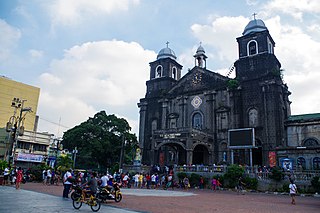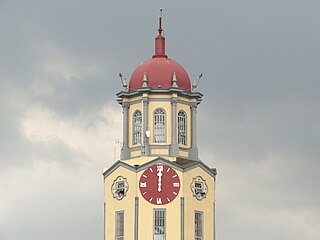Related Research Articles

Miguel López de Legazpi, also known as El Adelantado and El Viejo, was a Spanish conquistador who financed and led an expedition to conquer the Philippine islands in the mid-16th century. He was joined by Guido de Lavezares, relative Martin de Goiti, friar Andrés de Urdaneta, and his grandsons Juan and Felipe de Salcedo, in the expedition. Legazpi established the first Spanish settlement in the East Indies after his expedition crossed the Pacific Ocean, arriving in Cebu in 1565. He became the first Governor-General of the Spanish East Indies, which was administered from New Spain for the Spanish crown. It also encompassed other Pacific islands, namely Guam, the Mariana Islands, Palau, and the Carolinas. After obtaining peace with various indigenous tribes and kingdoms, he made Cebu City the capital of the Spanish East Indies in 1565 and later transferred to Manila in 1571. The capital city of the province of Albay bears his name.

Juan de Salcedo was a Spanish conquistador. He was the grandson of Spanish general Miguel López de Legazpi. Salcedo was one of the soldiers who accompanied the Spanish conquest to the Philippines in 1565. He joined the Spanish military in 1564 at age 15, on their voyage of exploration to the East Indies and the Pacific, in search of rich resources such as gold and spice, and to find a passage to the islands were the previous Spanish expeditions led by Ferdinand Magellan had landed in 1521, and Ruy López de Villalobos in 1543.

Tondo is a district located in Manila, Philippines. It is the largest, in terms of area and population, of Manila's sixteen districts, with a census-estimated 654,220 people in 2020. It consists of two congressional districts. It is also the second most densely populated district in the city.

Sulayman, sometimes referred to as Sulayman III, was a Crown Prince of the Kingdom of Luzon in the 16th century and was a nephew of King Ache of Luzon. He was the commander of Luzonian forces in the battle of Manila of 1570 against Spanish forces.
Lakandula was the title of the last lakan or paramount ruler of pre-colonial Tondo when the Spaniards first conquered the lands of the Pasig River delta in the Philippines in the 1570s.
Martín de Goiti was a Spanish conquistador and one of the soldiers who accompanied the Spanish voyage of exploration to the East Indies and the Pacific in 1565, in search of rich resources such as gold, spice and settlements. They were seeking to find a route to the islands were the previous Spanish expeditions led by Ferdinand Magellan had landed in 1521, and Ruy López de Villalobos in 1543.
Don Juan Macapagal, Datu of Arayat, was the great-grandson and the most eminent descendant of the last ruling Lakan (Emperor) of Tondo, Don Carlos Lacandola. Don Juan Macapagal was given the title Maestre de Campo General of the natives Arayat, Candaba and Apalit for his aid in suppressing the Kapampangan Revolt of 1660. He further aided the Spanish crown in suppressing the Pangasinan Revolt of Don Andres Malong in the same year, and the Ilocano Revolt of 1661. Don Juan Macapagal died in 1683. Don Juan Macapagal is a direct ancestor of Philippine Revolutionary General, Lázaro Macapagal and two former Philippine Presidents Diosdado Macapagal and his daughter, Gloria Macapagal Arroyo.

In early Philippine history, the Tagalog settlement at Tondo, sometimes referred to as the Kingdom of Tondo, was a major trade hub located on the northern part of the Pasig River delta, on Luzon island. Together with Maynila, the polity (bayan) that was also situated on the southern part of the Pasig River delta, had established a shared monopoly on the trade of Chinese goods throughout the rest of the Philippine archipelago, making it an established force in trade throughout Southeast Asia and East Asia.
The Tondo Conspiracy of 1587, popularly known as the Conspiracy of the Maginoos, also known as the Revolt of the Lakans, was a revolt planned by Tagalog nobles known as maginoos, led by Don Agustin de Legazpi of Tondo and his cousin Martin Pangan, to overthrow the Spanish government in the Philippines due to injustices against the Filipinos. It was territorially one of the largest conspiracies against the Spanish rule next to the Katipunan. It ranged from provinces near Manila all the way to the Calamianes Islands near Palawan.

The Battle of Bangkusay, on June 3, 1571, was a naval engagement that marked the last resistance by locals to the Spanish Empire's occupation and colonization of the Pasig River delta, which had been the site of the indigenous polities of Rajahnate of Maynila and Tondo.

Akí, also known as Rája Matandâ, was King of Luzon who ruled from the kingdom's capital Manila, now the capital of the Republic of the Philippines.

Tarik Sulayman, also spelled Tarik Soliman, is the most popular of several names attributed by Kapampangan historians to the individual that led the forces of Macabebe against the Spanish forces of Miguel López de Legazpi during the Battle of Bangkusay Channel on June 3, 1571. Aside from "Tarik Sulayman", this individual has also been associated with the names Bambalito or Bankau by some historians, while others simply consider him "nameless."

The earliest recorded history of Manila, the capital of the Philippines, dates back to the year 900 AD as recorded in the Laguna Copperplate Inscription. By the thirteenth century, the city consisted of a fortified settlement and trading quarter near the mouth of the Pasig River, the river that bisects the city into north and south.

The 1570 Battle of Manila was fought in Manila between Luzonians, led by Prince Sulayman, and Spaniards, led by field marshal Martin de Goiti, on 24 May 1570. Goiti's forces eventually besieged the fort of Manila, destroyed Manila, and won the battle, with the site of the fort falling to the Kingdom of the Spains and the Indies. The Spaniards then founded a Spanish city of Manila making it the capital of the Spanish East Indies.
Bulacan is a province of the Philippines. It was established on 15 August 1578.
In Philippine folk tradition, Rajah Salalila was the Rajah or paramount ruler of the early Indianized Philippine settlement of Maynila, and the father of the individual named Ache, who would eventually be well known as Rajah Matanda. Based on perceived similarities between the names, he is sometimes also called Sulaiman I in the belief that he shared the name of his supposed grandson, Rajah Sulayman.
Agustin de Legazpi is a prominent historical figure in the Philippines best known as the leader of the Tondo Conspiracy of 1587–1588, the last native ruler of Tondo, and the last individual to hold the title of paramount ruler in any of the Indianized indigenous Tagalog polities of the Pasig River delta, although it had been reduced to little more than a courtesy title by the time of Agustin de Legazpi's execution. He was a great grandson of the Bruneian Sultan and distant descendant of Caliph Hasan ibn Ali and was a convert from Islam to Christianity, his Bruneian name was Rajah Muhammad Zahir al-Din.
The term "Lakan Dula Documents" is used by Philippine historiographers to describe the section of the Spanish Archives in Manila which are dedicated to the genealogical records of the "Manila aristocracy" from the period immediately following European colonial contact. As of 2001, only one bundle of twelve folders remains in the archive, the rest having been lost, misplaced, or destroyed by various events such as the Japanese Occupation of Manila during World War II. The surviving bundle is labeled "Decendientes de Don Carlos Lacandola", and scholars use the term "Lacandola Documents" as an informal shortcut.
Kandarapa was a native Filipina princess of the Kingdom of Tondo in the island of Luzon during the 16th century Spanish conquest of the Philippines, and the wife of the Spanish conquistador Juan de Salcedo. She was described as a beautiful young woman who came from a tribal royal family. Kandarapa was the niece of Rajah Lakandula, the king of Tondo, and the daughter of Bunao Lakandula's sister, Princess Salanta, who became a widow at a young age. She was named after the native Filipino Kandarapa bird, a lark that frequently stayed amongst the rice padies, whose songs she imitated with her beautiful voice. Her uncle, the king, resisted conversion to Islam and remained to his native Filipino (Hindu-Malay) religion of his forebears and although Tondo was an older kingdom, it ceded power to Manila which was established as a satellite state subservient to the Sultanate of Brunei after a Bruneian settlement of Luzon. Islam was brought to the islands by preachers that had travelled from the islands of Borneo and Indonesia. During this period, Islam had slowly began converting the native tribes of Luzon. Lakandula, desirous of forging an alliance with the much more powerful Rajah of Macabebe, Tariq Sulayman, betrothed her niece to the Rajah of Macabebe, an arrangement Princess Kandarapa disapproved because he already had multiple wives from previous marriages as a result of his Islamic tradition. Had the Spaniards arrived a century later, the Philippines would have been an Islamic country.
References
- 1 2 3 4 Dery, Luis Camara (2001). A History of the Inarticulate. Quezon City: New Day Publishers. ISBN 971-10-1069-0.
- 1 2 3 4 Scott, William Henry (1994). Barangay: Sixteenth Century Philippine Culture and Society. Quezon City: Ateneo de Manila University Press. ISBN 971-550-135-4.
- ↑ Magat Salamat (1550–1589?), Participant in the Tondo Conspiracy Archived September 29, 2011, at the Wayback Machine , nhi.gov.ph
- 1 2 Zaide, Gregorio F. (November 1930). "Magat Salamat". Philippine Magazine. 27 (6). Manila: Philippine Education Company. Retrieved July 8, 2017.
- ↑ Gregorio F. Zaide, Philippine magazine, Volume 27, Number 6, November 1930, Philippine Education Company, Manila.
- ↑ Quirino, Carlos. Who's Who in Philippine History. Manila: Tahanan Books, 1995.
- ↑ Guillermo, Artemio R. (2011). Historical Dictionary of the Philippines. Scarecrow Press. p. 260.
- 1 2 Halili, M.C. (2004). Philippine History. Rex Bookstore, Inc. p. 111.